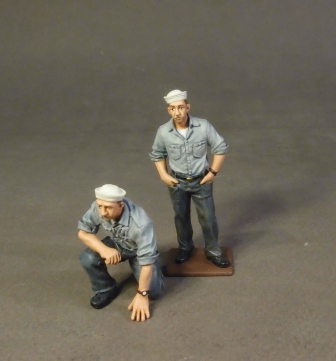
IWA-16
Uss Saratoga (CV-3),
Sailors
(2pcs) US$78
The Interwar Aviation series covers aircraft that were developed
and used between World War 1 and World War 2,
and was known as the “Golden Age of Aviation.”
In the two decades between the end of World War 1
and the start of World War 2,
military aviation underwent a complete transformation.
The typical combat aircraft of 1918
was a fabric-covered externally braced biplane
with fixed landing gear and open cockpits.
Few aero engines developed as much as 250 horsepower,
and top speeds of 200 km (120 miles) per hour were exceptional.
By 1939 the first-line combat aircraft of the major powers
were all-metal monoplanes with retractable landing gear.
Most early aircraft carriers were conversions of ships
that were laid down (or had even served) as different ship types:
cargo ships, cruisers, battlecruisers, or battleships.
During the 1920s, several navies started ordering
and building aircraft carriers that were specifically designed as such.
This allowed the design to be specialized to their future role,
and resulted in superior ships. During the Second World War,
these ships would become the backbone of the carrier forces of the US,
British, and Japanese navies, known as fleet carriers.
USS Saratoga (CV-3) was a Lexington-class aircraft
carrier built for the United States Navy during the 1920s.
Originally designed as a battlecruiser,
she was converted into one of the Navy's first aircraft
carriers during construction to comply with the Washington Naval Treaty of 1922.
The ship entered service in 1928
and was assigned to the Pacific Fleet for her entire career.
Saratoga and her sister ship, Lexington,
were used to develop and refine carrier tactics
in a series of annual exercises before World War II.
On more than one occasion these included
successful surprise attacks on Pearl Harbor, Hawaii.
She was one of three prewar US fleet aircraft carriers,
along with Enterprise and Ranger,
to serve throughout World War II.
A U.S. Navy Aircraftcarrier's deck crew exists to do one thing:
to consistently put aircraft into the air and safely recover them after they launch.
In order to make this happen, there exists a small army of flight deck facilitators,
and each individual has their own role primarily designated by the color of the shirt they wear.
We now accept PAYPAL,
to purchase your figures please send your order by e-mail to
inquiry@johnjenkinsdesigns.com
after checking that everything is available,
you will be billed via PAYPAL.
your order will be shipped on confirmation of payment.
worldwide airmail 12%
(minimum postage us$10)
JOHN JENKINS DESIGNS
UNIT 6E, TOWER 2,
KING LEY INDUSTRIAL BUILDING,
33-35 YIP KAN STREET,
WONG CHUK HANG,
HONG KONG
Tel: 852 9041 9065
